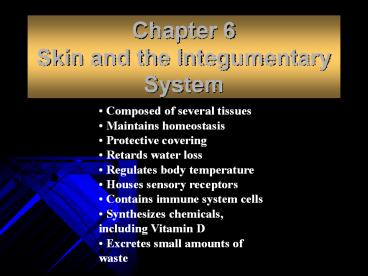Chapter 6 Skin and the Integumentary System - PowerPoint PPT Presentation
Title:
Chapter 6 Skin and the Integumentary System
Description:
Chapter 6 Skin and the Integumentary System Composed of several tissues Maintains homeostasis Protective covering Retards water loss Regulates body temperature – PowerPoint PPT presentation
Number of Views:1063
Avg rating:3.0/5.0
Title: Chapter 6 Skin and the Integumentary System
1
Chapter 6Skin and the Integumentary System
- Composed of several tissues
- Maintains homeostasis
- Protective covering
- Retards water loss
- Regulates body temperature
- Houses sensory receptors
- Contains immune system cells
- Synthesizes chemicals, including Vitamin D
- Excretes small amounts of waste
2
Layers of Skin
- Epidermis
- Dermis
- Subcutaneous layer
3
Epidermis, Dermis, Basement Membrane
- Epidermis is subdivided into layers of stratified
squamous epithelium - Dermis is made up of connective tissue,
epithelial tissue, smooth muscle tissue, nervous
tissue, and blood. - Basement membrane is anchored to the dermis by
short fibrils and separates these two layers of
skin
4
Epidermis
- lacks blood vessels
- keratinized
- thickest on palms and soles (0.8-1.4mm)
- melanocytes provide melanin
- rests on basement membrane
- stratified squamous
5
Epidermis
- Layers of Epidermis
- stratum corneum
- stratum lucidum
- stratum granulosum
- stratum spinosum
- stratum basale
6
(No Transcript)
7
Layers of the Epidermis
8
Skin Changes Rashes
9
Chicken Pox
Shingles
Impetigo
Lyme Disease
10
Melanocytes and Pigment Granules
11
All people have the same number of melanocytes in
their skin
12
Albinism Lack of Melanin
13
Paul Bettany in Columbia Pictures' The Da Vinci
Code - 2005
THE ALBINO MONK?
14
Dermis
- on average 1.0-2.0mm thick
- dermal papillae
- binds epidermis to underlying tissues
- irregular dense connective tissue
- muscle cells
- nerve cell processes
- blood vessels
- hair follicles
- glands
15
(No Transcript)
16
Subcutaneous Layer
- hypodermis
- loose connective tissue
- adipose tissue
- insulates
- major blood vessels
17
Hair Follicles
- epidermal cells
- tube-like depression
- extends into dermis
- hair root
- hair shaft
- hair papilla
- dead epidermal cells
- melanin
- arrector pili muscle
18
(No Transcript)
19
(No Transcript)
20
Greys Anatomy
With age, a loss of melanin in hair can lead to
grayness.
EXAMPLES OF HAIR COLOR VARIATION
Red Heads have iron pigment (trichosiderin)
Everyone except albinos have various amounts of
melanin in their hair.
21
Nails
- protective coverings
- nail plate
- nail bed
- lunula
6-9
22
Sebaceous Glands
- usually associated with hair follicles
- holocrine glands disintegrating cell and its
contents for the secretion
- secrete sebum
- absent on palms and soles
23
(No Transcript)
24
Sweat or Sudoriferous Glands
- widespread in skin
- deeper dermis or hypodermis
- eccrine glands types of merocrine gland that
secrete fluid (sweat) product released through
the cell membrane
- aprocrine sweat, ceruminous (wax), mammary
(milk) glands types of aporocrine glands that
secrete cellular product and portion of the free
ends of cells
25
(No Transcript)
26
Regulation of Body Temperature
27
(No Transcript)
28
Problems in Temperature Regulation
Hyperthermia abnormally high body temperature
Human Body Temperature 37o C or 98.6o F.
Hypothermia abnormally low body temperature
29
Skin Color
- Genetic Factors
- varying amounts of
- melanin
- varying size of melanin
- granules
- albinos lack melanin
- Physiological Factors
- dilation of dermal blood vessels
- constriction of dermal blood vessels
- carotene
- jaundice
- Environmental Factors
- sunlight
- UV light from sunlamps
- X rays
George Hamilton sun worshiper?
30
The Tan Man at The University of Kansas
http//www2.ljworld.com/news/2006/may/03/hes_still
_tan_after_all_these_years/?city_local
31
Healing of Cuts
32
(No Transcript)
33
(No Transcript)
34
Healing of Burns
First degree burn superficial partial-thickness
(epidermis damaged)
Second degree burn deep partial-thickness
(epidermis dermis damaged)
- Third degree burn full-thickness (epidermis,
dermis, accessory skin structures) - autograft (self-transplant)
- homograft (temporary transplant from donor)
- various skin substitutes
- extensive scars
35
Rule of Nines
36
Life Span Changes
- Melanin production slows
- Hair thins
- Number of hair follicles decrease
- Impaired nail growth
- Sensory receptors decline
- Inability to control body temperature
- Less vitamin D production
- Scaly skin
- Age spots
- Dermis becomes reduced
- Loss of fat
- Wrinkles
- Sagging
- Sebaceous glands secrete less oil
37
Life Span Changes - Skin
38
Clinical Application
Acne Vulgaris
- most common skin disorder
- sebum and epithelial cells clog glands
- produces whiteheads and blackheads (comedones)
- anaerobic bacteria trigger inflammation (pimple)
- largely hormonally induced
- androgens stimulate sebum production
- treatments include antibiotics, topical creams,
birth control pills
39
(No Transcript)
40
Common Skin Disorders
- Athletes foot tinea pedis or ringworm fungal
infection of the foot. - Birthmark congenital blemish or spot on the
skin. - Boil bacterial infection of the skin produced
when bacteria enter a hair follicle. - Carbucnle bacterial infection, similar to a
boil, that spreads into the subcutaneous tissues. - Cyst fluid-filled capsule.
- Eczema noncontagious skin rash.
- Erythema reddening of the skin due to dilation
of dermal blood vessels in response to injury or
inflammation. - Herpes characterize by a recurring formations of
small clusters of vesicles usually caused by
herpes simplex virus contagious. - Keloid elevated enlarging fibrous scar usually
initiated by an injury. - Mole fleshy skin tumor that is usually
pigmented. - Pediculosis disease produced by an infestation
of lice. - Pruritus itching of the skin.
- Pusule elevated, pus-filled area.
41
Xeroderma Pigmentosum
- Extreme freckling and skin cancer due to lack of
DNA repair enzymes.
42
Types of Skin Cancer
Squamous cell carcinoma derived from epithelial
tissue
Basal cell carcinoma derived from epithelial
tissue
Malignant melanoma derived from melanocytes






























